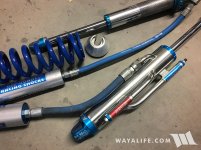Benito
Caught the Bug
Ha ha. Guess that sort of answers the question. I went through this same dilemma with my JK between COs and Bypass.
He is referring to shocks with a bypass tube for the fluid to travel back and forth to better keep it cool. Reducing shock fade. Basically those shocks you see that have an extra cylinder on them or attached to them
I may be wrong but are both of you talking about a remote reservoir shock?
Ben, you’re describing a remote res shock. Although having more fluid does keep it cooler and in return reduces shock fade because of more fluid the primary reason for having a res is to have two separate chambers for air and oil. When the shock is compressed and the shaft enters the cylinder the oil that is in the cylinder needs to be displaced since the oil does not compress, the oil from the shock moves to the res and the air in the res compresses. vs an emulsion shock that has air and oil mixed together in the cylinder.
A bypass shock does have a reservoir for the same reason but it also has bypass tubes that allow oil to flow through the bypass tube, bypassing the piston (and shims) in the shock allowing you to tune the compression and rebound rate throughout the stroke of the shock depending on how many tubes and the orientation of the tube.

